Linguistic convergence between Hebrew and Phoenician

Phoenician is considered a derivation of the Canaanite language, and historians confirm that the Hebrew language is the closest language to Phoenician. Indeed, many historians consider that Phoenician is one of the dialects of the Hebrew language and that it was formed by being influenced by the language of the Egyptians.
The German historian and language expert William Gesenius said in his book in 1828 AD, “The Phoenician language is merely a Hebrew dialect.”

In the book (Mémoires sur la langue celtique) from the year 1750 AD by the French historian, linguist and theologian (Gian Baptiste Paulet), he says: Punic is a Hebrew dialect.
The author of the book Herodotus’ History from 1780 AD says: “Anubis in Egyptian, pronounced nbé in Hebrew, and in Phoenician, which is nothing but a Hebrew dialect, enbé.”

The Phoenician language and the so-called ancient Hebrew language are almost identical, as indicated by the Samaritan Torah, which preserves these ancient texts.
In the book Hebrew Grammar from 1860 AD, its author says, “We can confirm that Phoenician is nothing but a Hebrew dialect.”
In the book Toison d'or de Langue Phénicienne:
The historian says, “We can consider Phoenician and Hebrew to be the same language, except for some minor modifications.”
Saint Jerome says: ((The language of Sidon is almost the same as the Hebrew language. Just as in Punic, the same thing is in Hebrew. The word Alma in both languages means virgin))

Saint Augustine says: ((There is no significant difference between Punic and Hebrew... [He points out some identical words])))
In one of the international encyclopedias of languages, it is mentioned that Phoenician is closely related to Hebrew and Egyptian, and some historical evidence is cited in the way of writing and some terminology.
According to historians, the Hebrew language is derived from the Canaanite language, which is considered the mother tongue of the people of Canaan, followed by the ancient Hebrew language, then Phoenician was derived from it, then from Phoenician appeared Punic, which is a mixture between ancient Numidian and Phoenician.

2. Biblical Phoenician Language (“Biblical Hebrew”) - More than 3,000 years ago, when the Israelites conquered and replaced the Canaanites in Israel, Hebrew was established as the national language.
Later, Phoenician-Hebrew came to be used exclusively in the Temple and in synagogues, while the "common language" of the Israelites became Aramaic, spoken by all residents of the region. As a result, the Holy Scriptures were translated into Aramaic, especially during the Babylonian exile (686-534 BC). For more than 1,500 years, until about 400 AD, it fell out of common use. Biblical Hebrew has survived as the language of Jewish liturgy and religious texts.

5. Modern Hebrew - In the nineteenth century, Biblical Hebrew, fueled by the Zionist movement, experienced a revival. Eliezer Ben-Yehuda and other authors and poets joined forces to make Hebrew the official language of Israel in 1948. As a result, Hebrew is now a language that represents a rich and wonderful expression of Israel. This must be accepted without any reservation.
Source: websites

